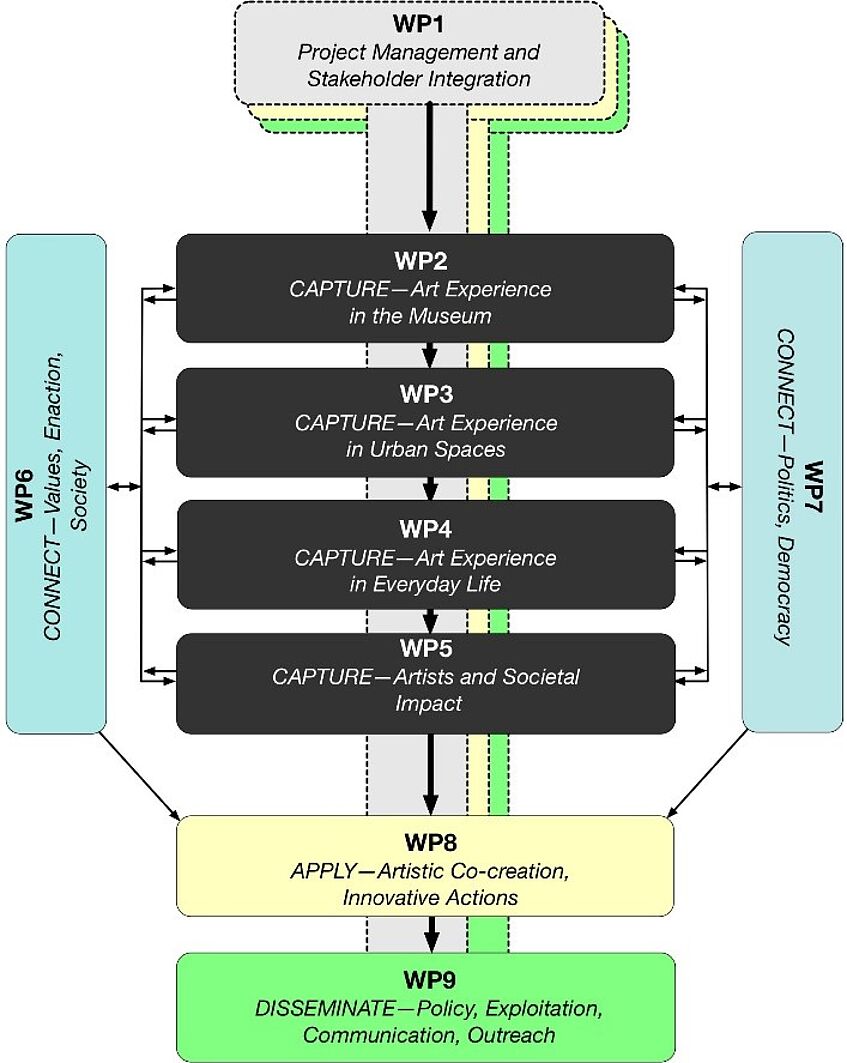Work plan — Work packages, deliverables

Fig 8. ARTIS WP organization
Work plan — Work packages, deliverables
ARTIS will be implemented over four years with 9 Work Packages (WPs), and sub-divided into four main phases, designed to systematically achieve our objectives:
CAPTURE (WP2-5): We will conduct a core of empirical studies of art experiences onsite with selected artworks and viewers in museums, urban, and everyday settings. We also will conduct interviews and collect data with working artists, to provide the empirical
ground for a broader understanding and quantification of: What is the psychological and empirical nature of our possible interactions with art; If and How experiences can be transformative; What are the specific impacts on individual and social levels as a result of experiences; What are key contextual, design, or viewer/artist factors that increase transformative potential or pose barriers to art’s efficacy or enjoyment? This phase will also identify what specific artworks and settings do demonstrate ability to be transformative or to meet the H2020 call of “generating new thinking, engagement and action in relation to contemporary societal challenges in Europe,” as well as test preliminary perceiver-directed interventions that can increase art’s transformative potential. (Objective 1).
CONNECT (WP6-7): In parallel to our onsite empirical assessments of perceivers and artists, we will consider perspectives of other stakeholders from academic and applied domains and connect the empirical data to philosophical or critical-historical discussions regarding art, and wider social, cultural, and political contexts. This phase will identify especially How these socio-cultural levels engage
with, promote, or restrict, transformation as a goal or outcome of art, and How art experiences or initiatives transform social, political, and theoretical or educational structures. (Objective 2). We will also continuously seek to translate the empirical findings to these other levels as well as seek input in a collaborative bottom-up policy and practice-based research approach to maximum impact for these stakeholders.
APPLY (WP8): The above WPs will feed directly into a series of co-creations and collaborations with working and aspiring artists (WP8), carried out at our art university partners and in conjunction with gallery and societal stakeholders. We will explore and create art interventions toward the goal of creating social change or transformation through art. These interventions will serve as dynamic research laboratories in their own right, allowing us to both test the efficacy of the produced interventions and to create innovative solutions to the question of How multiple art stakeholders can be mobilized to produce transformations or address societal challenges through art. (Objective 3).
DISSEMINATE (WP9): The empirical data and results from artist-collaborations will culminate in a work package in which we will both explore and craft new art policy. We will structurally communicate the results to stakeholders at the community, institutional, art educational, and governmental levels—equipped with actionable, empirically-grounded evidence and tools for discussing, identifying, testing, and promoting the efficacy of art (Objective 4).
Although the project builds toward innovative art production, education, and policy applications, we will work with stakeholders throughout the entire project, treating them, from the earliest stage, as co- researchers with the goal of crafting bottom-up, empirically-grounded solutions, and dynamically adjusting the project in order to maximize impact for these diverse areas. To that end, WP1, constituting the backbone of the project, is devoted to both management and to partners/stakeholder communication.
